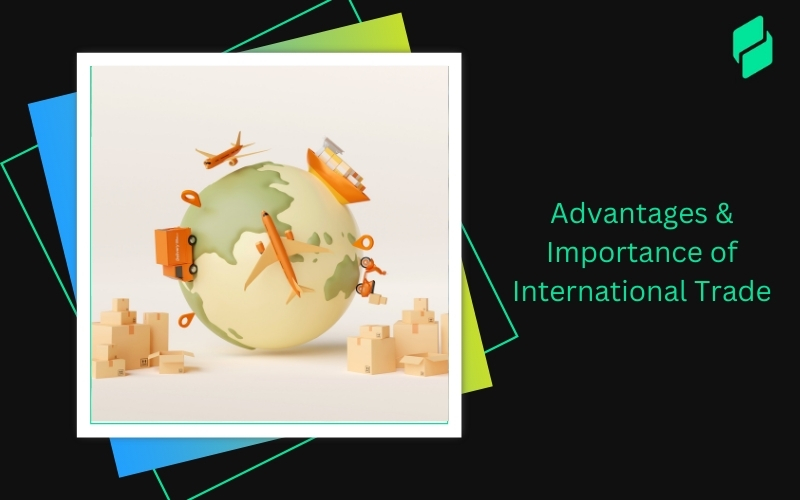Optimize your business: use unlimited savings with Pazago fulfilled now!
Get Started ->Are you aware that the global economy hinges not just on the products you buy but on the subtle numbers that track how they're shipped?
These numbers are part of the container index, a critical tool for anyone in shipping, import, export, or logistics.
This index isn't just a set of numbers; it's the pulse of international commerce, giving us real-time insights into the economic health of our interconnected world.
What is a Container Index?
A container index is a crucial metric in the shipping industry. It provides a snapshot of freight rates for container transport across major routes worldwide. Think of it as a barometer measuring global economic activity's temperature.
When you hear about the "container index," you refer to data points that track the cost of transporting goods in the large metal boxes you see on ships and trains.
The Significance of Container Indices in Global Trade
Why should you care about these indices? Because they directly affect the price of nearly every product you purchase. They indicate supply chain fluidity, economic health, and trade barriers.
Container indices can provide early warnings of potential increases in consumer goods prices during economic turbulence or geopolitical tension.
Container Indices: The Barometer of the Shipping Industry’s Health
Think of container indices as the pulse of the global shipping industry. When indices rise, it often signals a surge in demand for vessel space, possibly leading to increased shipping costs.
Conversely, a decline might indicate an oversupply of ships or diminishing demand. These trends are crucial for businesses involved in import and export, logistics, and supply chain management, helping them make informed decisions about stock management and pricing strategies.
Exploring the Different Types of Container Indices
Each container index serves a unique purpose, from the Shanghai Containerized Freight Index (SCFI) to the World Container Index (WCI) and the Harpex Index.
These indices vary based on geographical focus, type of cargo, and the specific routes they monitor. Tracking different market segments offers a granular view of the shipping industry’s dynamics.
1. Shanghai Containerized Freight Index (SCFI)
- Overview and Calculation Method: The SCFI measures spot freight rates of export containers from Shanghai to various global destinations. Calculated weekly, it bases its figures on the actual rates freight forwarders pay to ship containerized cargo.
- Key Ports, Routes, and Trade Lanes Covered: This index focuses on significant routes leading out of Shanghai, covering pivotal destinations across the Americas, Europe, and Asia.
- Components and Major Routes Covered: The SCFI includes comprehensive coverage of trans-Pacific, trans-Atlantic, and Asia-Europe routes, providing stakeholders with crucial insights into the most active and commercially significant shipping lanes.
2. World Container Index (WCI)
- Overview and Calculation Method: Assessed by Drewry, the WCI is a composite of container freight rates on eight major routes connecting the US, Europe, and Asia. It is updated every week and reflects comprehensive market-driven data.
- Key Ports, Routes, and Trade Lanes Covered: The WCI covers key global maritime hubs, including Rotterdam, New York, Shanghai, and Los Angeles.
- Components and Major Routes Covered: The index offers detailed insights into east-west and north-south trade lanes, highlighting the economic pulse of global trade flows.
3. Hamburg Shipbrokers' Association Container Index (HAX)
- Overview and Calculation Method: The HAX tracks spot market rates for container shipping based on real-time data from Hamburg, a central European logistic hub.
- Key Ports, Routes, and Trade Lanes Covered: Focused primarily on European routes, the HAX provides insights into the container traffic moving through Hamburg, which is pivotal for European trade.
- Components and Major Routes Covered: It extensively covers the North Atlantic trade route, which is crucial for trans-European logistic operations.
4. China Containerized Freight Index (CCFI)
- Overview and Calculation Method: The CCFI tracks spot and contractual freight rates from major Chinese ports, providing a broader perspective than the SCFI.
- Key Ports, Routes, and Trade Lanes Covered: It encompasses a wide range of Chinese ports, offering a panoramic view of China’s involvement in global trade.
- Components and Major Routes Covered: The CCFI includes routes from Asia to North America, Europe, and beyond, making it a comprehensive index for global stakeholders.
5. Harpex Index
- Overview and Calculation Method: The Harpex Index tracks container ship charter rates across various vessel sizes, reflecting the demand and supply dynamics of the shipping market.
- Key Ports, Routes, and Trade Lanes Covered: While Harpex does not specify routes, it is influenced by global container shipping trends and chartering activities.
- Components and Major Routes Covered: The index is sensitive to changes in the major trading blocks and often reflects shifts in the broader container shipping market.
6. New York Shipping Exchange (NYSHEX) Forward Contract Index
- Overview and Calculation Method: This index offers a forward-looking perspective by tracking the pricing of forward contracts for container shipping, reflecting future market expectations.
- Key Ports, Routes, and Trade Lanes Covered: NYSHEX primarily focuses on the U.S. market but offers insights relevant to international shipping stakeholders.
- Components and Major Routes Covered: It covers a variety of trade lanes, particularly those impacting the U.S. import and export sectors.
7. Baltic Dry Index (BDI)
- Overview and Calculation Method: Primarily known for bulk carriers, the BDI indirectly influences the container sector by providing insights into the overall health of the shipping market.
- Key Ports, Routes, and Trade Lanes Covered: It covers global shipping routes but focuses more on bulk commodities.
- Components and Major Routes Covered: Although not a direct container index, its fluctuations offer indirect insights into container shipping trends.
8. Freightos Baltic Global Container Index (FBX)
- Overview and Calculation Method: The FBX tracks real-time container spot rates across major global shipping lanes, updated weekly.
- Key Ports, Routes, and Trade Lanes Covered: It spans major international shipping lanes, including Asia to the U.S. West Coast and Europe to the U.S. East Coast.
- Components and Major Routes Covered: This index provides immediate, actionable data that reflects the current state of global container shipping rates.
Which container index best suits your needs? With Pazago, you can explore tailored insights and optimize your shipping decisions. Boost your efficiency with Pazago now!
Key Features of Global Freight Indexes

Now, let’s break down the methodologies behind these indices, notably the Freightos Baltic Global Container Index (FBX) and the World Container Index (WCI), and explore why real-time data and composite indices are vital in understanding market rates.
Comparison of Methodologies: FBX vs. WCI
When you look at container indices like the FBX and WCI, you might wonder how they differ. Both are pivotal in setting and predicting freight rates, but their methodologies offer distinct insights.
Freightos Baltic Global Container Index (FBX) employs a real-time transaction-based methodology. This means it captures live transaction data, providing an up-to-the-minute reflection of market rates.
This approach is invaluable for businesses needing immediate pricing trends to make quick shipping decisions.
On the other hand, the World Container Index (WCI), as assessed by Drewry, uses a composite methodology. It averages freight rates across major global shipping routes every week.
While not as immediate as FBX, WCI offers a robust reflection of market conditions over a slightly longer term, which is helpful for strategic planning and budget forecasts in logistics.
Role of Composite Indices in Understanding Market Rates
Composite indices like the WCI are essential for a panoramic view of the shipping industry. By aggregating data across various routes, these indices provide a balanced outlook that can buffer against the volatility in single-route data.
For businesses, this means a more stable base for making long-term decisions, mitigating risks associated with sudden market fluctuations.
Significance of Real-Time Data for Accurate Rate Tracking
In a world where market conditions change by the minute, the significance of real-time data cannot be overstated. Indices like FBX provide this, offering logistics managers and business owners the agility to react swiftly to market changes.
This real-time tracking is not just about keeping pace with the market; it's about securing cost-effective shipping options before rates spike or planning inventory in response to emerging market trends.
When it comes to adapting to these economic fluctuations, Pazago’s platform offers a bird' s-eye view of the global trade landscape, guiding import-export businesses toward strategic decisions that capitalize on these trends.
Impact on Ocean Freight Pricing and Industry Trends
Container indices serve as a barometer for the shipping industry, capturing the ebbs and flows of market conditions.
When demand for shipping spikes, so do the indices; when the market faces a downturn, the index reflects that, too. This fluctuation can be a rollercoaster ride, with prices and availability changing sometimes daily.
For anyone involved in shipping, monitoring these indices isn't just helpful; it's essential for staying ahead in a market that does not pause.
The Utility of Indices in Ocean Freight Procurement and Decision-Making
Imagine you're responsible for a multinational company's logistics. How do you decide when to ship your goods or which route to take?
This is where container indices come into play. They provide you with the data needed to make informed decisions about freight procurement.
By analyzing trends in these indices, you can predict cost changes and choose the most economical time to transport goods, optimizing your supply chain and reducing expenses.
Current Market Trends Based on Index Data
The container index data suggests a trend toward gradual stabilization in shipping rates after the tumultuous peaks seen during recent global disruptions. However, this stabilization is tentative, with regional discrepancies driven by differing levels of demand and supply chain resilience.
Understanding these trends allows businesses to strategize their operations effectively, adapting to short-term fluctuations and long-term shifts in the global shipping landscape.
Influence of External Factors like Congestion and Labor Disputes on Indices
External factors such as port congestion and labour disputes can significantly sway container indices. For example, congestion in significant ports like Los Angeles or Rotterdam can lead to delays and increased costs, which are quickly reflected in the index.
Similarly, labour disputes or strikes can halt operations at critical junctures, causing a ripple effect throughout the global supply chain. These indices help stakeholders gauge the impact of such events and implement contingency plans to mitigate adverse effects.
Worried about changing freight rates? Use Pazago to gain stability and predict market trends accurately. Stabilize your shipping costs with Pazago!
Future Outlook of Container Indices in Global Shipping

"To navigate future waters in global shipping, one must first read the stars of today's shipping indices." Just as ancient mariners used the stars to guide their journeys, modern businesses rely on container indices to navigate the complex seas of international trade.
Let’s explore why these indices are becoming increasingly pivotal for forecasting and strategic planning and what changes we can anticipate in freight rates.
Role of Indices in Rate Stabilization
Looking ahead, the volatility in global markets suggests that freight rates may continue to experience fluctuations due to varying factors like geopolitical tensions, economic shifts, and environmental policies.
However, container indices play a crucial role in rate stabilization by providing transparency and consistency in pricing. They help businesses prepare for potential cost surges and enable more stable budgeting and forecasting.
These indices help companies strategize their shipping needs to capitalize on lower rates or brace for expected increases, making them indispensable tools in financial planning.
Comparative Analysis for a Comprehensive Market Overview
A comparative analysis of various container indices is essential to understand the scope and impact of changes within the shipping industry.
Each index, from the Shanghai Containerized Freight Index (SCFI) to the World Container Index (WCI) and the Freightos Baltic Global Container Index (FBX), offers unique perspectives covering different routes, cargo types, and market conditions.
By comparing these indices, stakeholders gain a holistic view of the global shipping environment, enabling them to make more nuanced and strategic decisions.
This comparative analysis observes numbers and interprets their stories about economic health, consumer demand, and global trade flows.
Conclusion
As explored throughout this article, container indices are not just statistical data but the backbone of decision-making in the global shipping industry.
So, whether you are negotiating freight contracts, planning logistic operations, or simply seeking a competitive edge in the marketplace, remember that the container index is your strategic ally.
Your insight into the present and your forecast for the future enables you to navigate successfully in the competitive and ever-changing realm of global shipping.
Need a reliable partner to navigate global trade complexities? Pazago is ready to help your business expand effortlessly. Start your journey with Pazago today!


.png)








